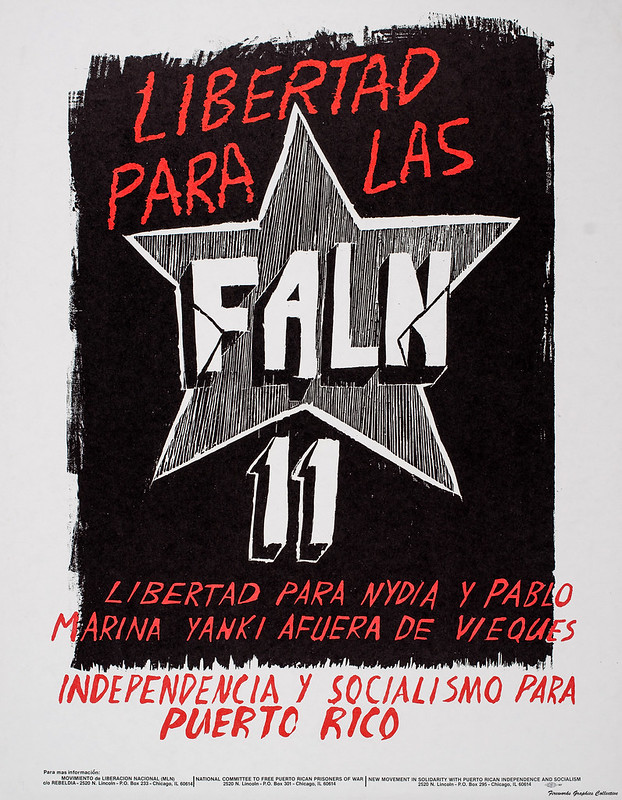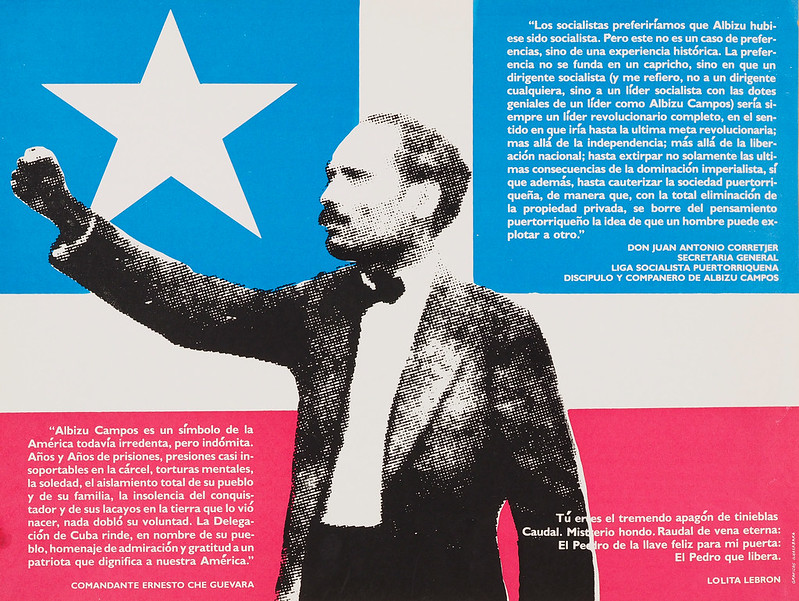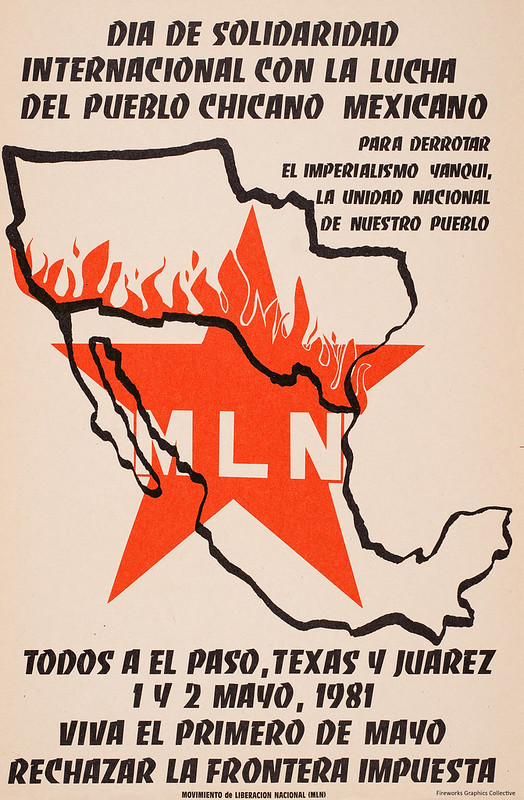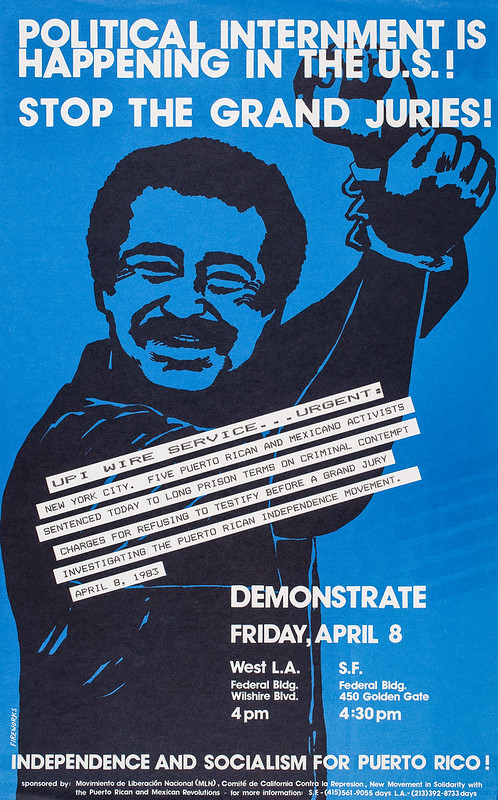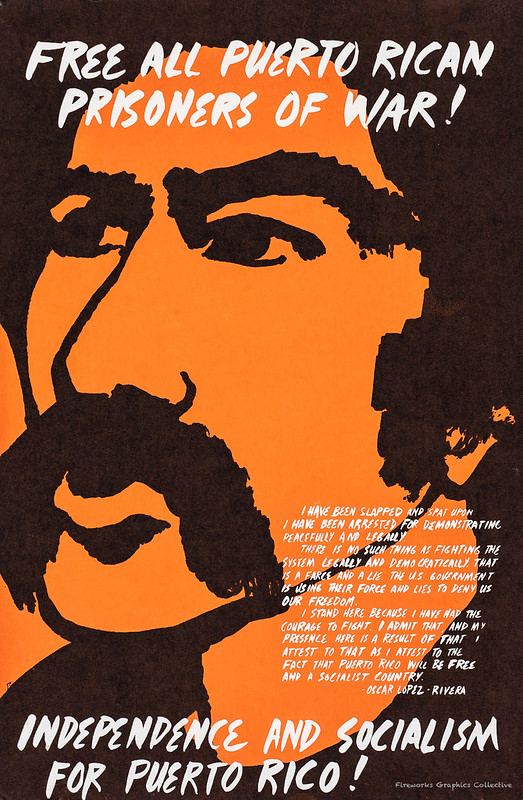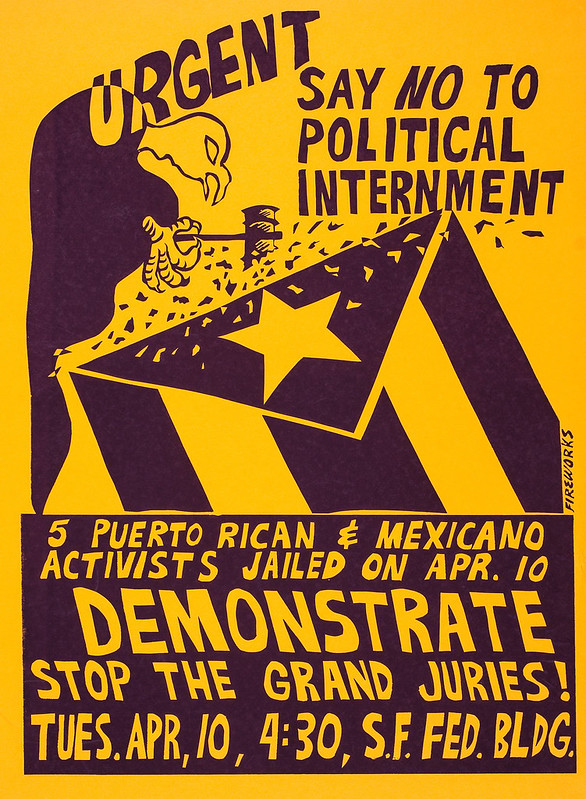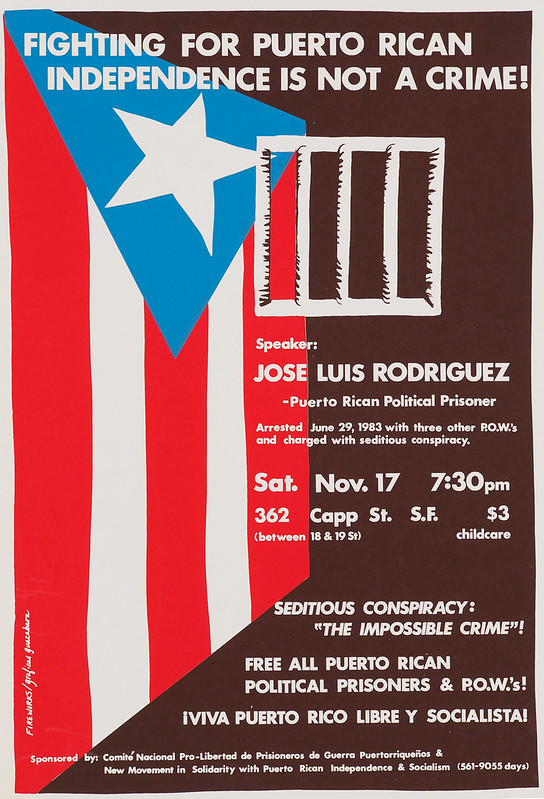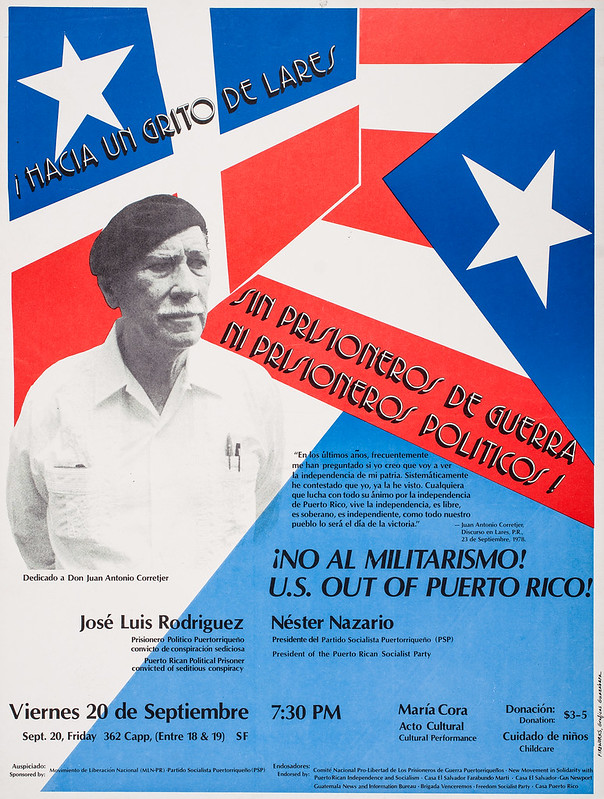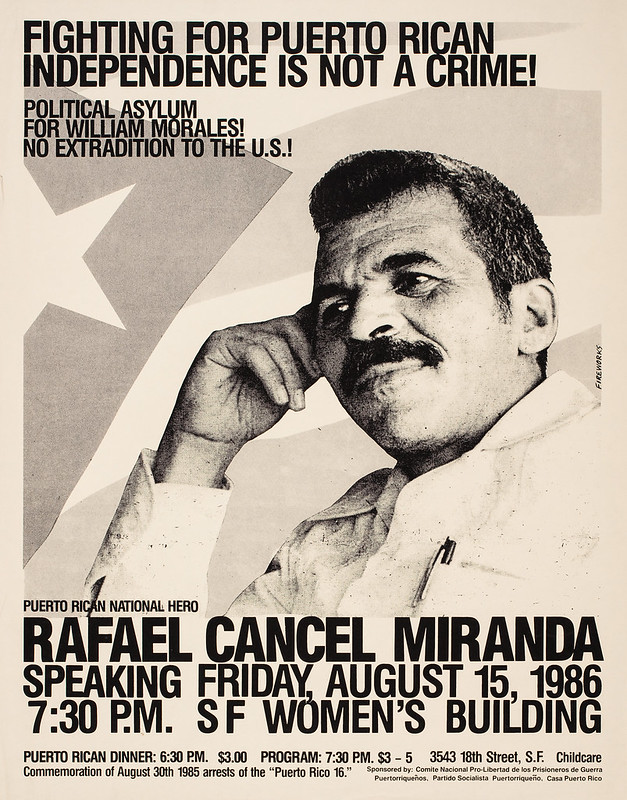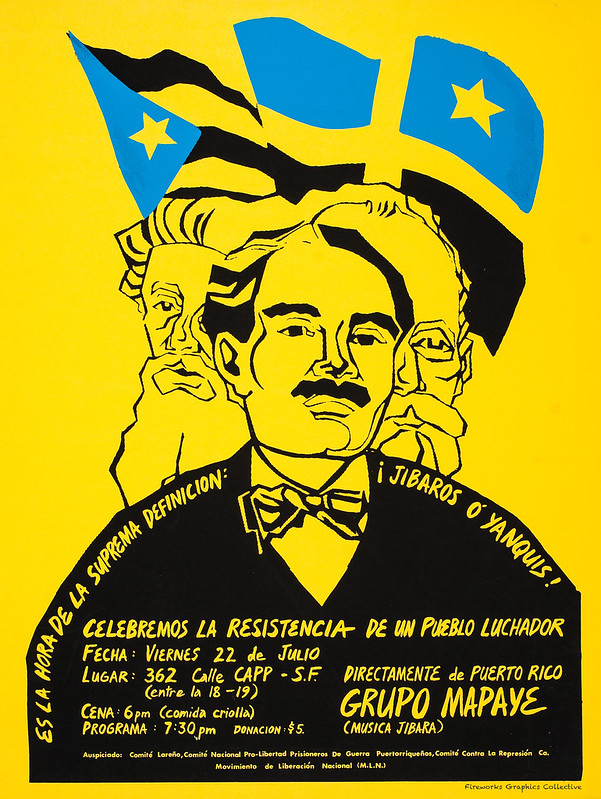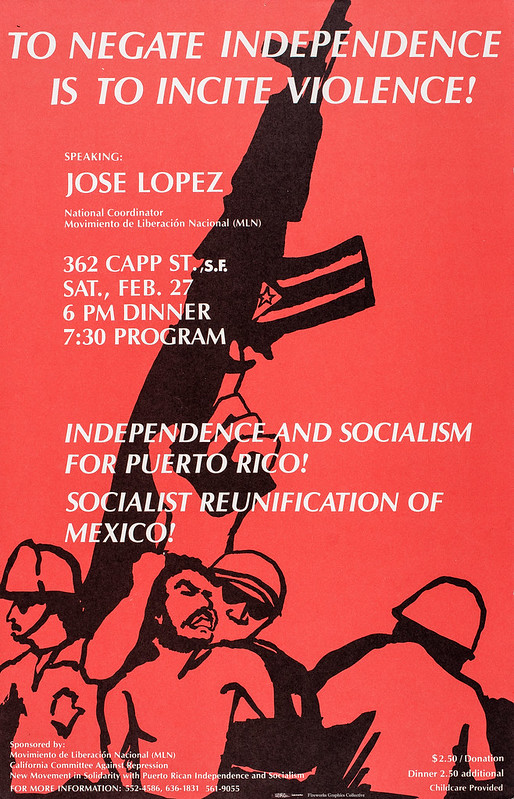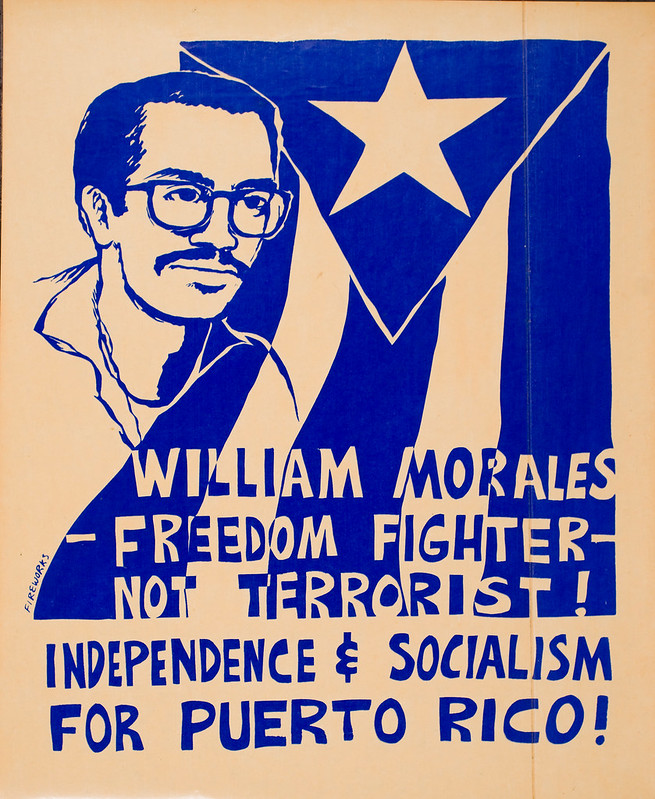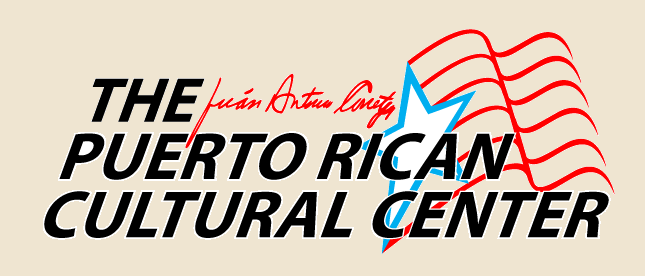- In the US, anyone refusing to cooperate with a Grand Jury can be held in jail with a civic, “non-criminal” charge for the duration of the Grand Jury (usually 18 months). In practice, the US uses the Grand Juries as a form of “political internment” to punish activists for their opposition to US government policies and practices. The US and the FBI have been using Grand Juries to imprison Puerto Rican independence activists starting in the 1930s with the Nationalist Party. In the 1970s and 80s theJustice Department convened several grand juries to investigate organizations of Puerto Ricans, US Black and Mexicano organizations, and white anti-imperialist groups. Subpoenas were issued for independence leaders in Chicago, New York, and Puerto Rico; as well as to Mexican activists in the US. Citing the principle of “non- collaboration,” many refused to cooperate and were then charged with criminal contempt and sentenced to five years in prison.
- The conquest and settlement of the northern part of Mexico by the US in the 1840’s is a relatively recent event in the history of La Raza on this continent. The US tries to represent the current border between the US and Mexico as fixed and eternal, to hide the historic and continuous relationship between Chicano/ Mejicano struggle within the US and Mejicano struggle in Mexico. This poster, produced in 1981 at the El Paso/Juarez conference (poster 115) shows that the heroes of the chicano and mexicano movements transcend the imperialist borders established by the US. Center: Francisco “Pancho Villa, a leader in the Mexican Revolution. Top left: Ricardo Flores Magon, one of three brothers, was a noted anarchist and revolutionary thinker. Top Center: Genaro Vasquez Rojas, leader of the guerrilla organization, Asociación Nacional Revolucionaria (National Revolutionary Association), developed out of the state of Guerrero. Top right is a pecan sheller from an historic strike in San Antonio in the 1930’s. Center right is Valentina Ramirez Avitia, also known as a soldadera, a woman who fought in the Mexican revolution under the name Juan Ramirez, when women were not allowed to join the army. Bottom left, Ricardo Falcon, a student and a leader of the Chicano movement, was killed in a racist incident in 1972. Center left, Juana Belen Gutierrez de Mendoza, Mexican anarchist, feminist, and journalist, and a Caxcan Indian from the state of Durango.[3]
- In the US, anyone refusing to cooperate with a Grand Jury can be held in jail with a civic, “non-criminal” charge for the duration of the Grand Jury (usually 18 months). In practice, the US uses the Grand Juries as a form of “political internment” to punish activists for their opposition to US government policies and practices. The US and the FBI have been using Grand Juries to imprison Puerto Rican independence activists starting in the 1930s with the Nationalist Party. In the 1970s and 80s theJustice Department convened several grand juries to investigate organizations of Puerto Ricans, US Black and Mexicano organizations, and white anti-imperialist groups. Subpoenas were issued for independence leaders in Chicago, New York, and Puerto Rico; as well as to Mexican activists in the US. Citing the principle of “non- collaboration,” many refused to cooperate and were then charged with criminal contempt and sentenced to five years in prison.
- On April 4, 1980 Eleven national liberation fighters for Puerto Rican independence were captured by local police in Evanston, Illinois and accused of being members of the Fuerzas Armadas de Liberación Nacional (FALN). Immediately upon their arrest, the Eleven rejected the criminal charges taking the position that they are armed combatants of the Puerto Rican struggle against colonialism. They demanded to be treated as Prisoners of War in accordance with the Geneva Convention and other International Law. As such, they did not participate in any of their legal proceedings. Instead, by turning their backs to the judge and addressing their supporters, they turned the courtroom into another arena of struggle for Puerto Rican independence. In 1977 Pablo Marcano and Nydia Cuevas Rivera, took as hostage.the Consul General of the Chilean Consulate in Puerto Rico. They demanded the release of the Puerto Rican Nationalist prisoners as well as the ceasing of July 4th celebrations on the island. When the Nationalists were released in 1979, they campaigned for the release of these two independentistas. freedomarchives.org/Documents/Finder/DOC41_scans/41.Colon…
- On April 4, 1980 Eleven national liberation fighters for Puerto Rican independence were captured by local police in Evanston, Illinois and accused of being members of the Fuerzas Armadas de Liberación Nacional (FALN). Immediately upon their arrest, the Eleven rejected the criminal charges taking the position that they are armed combatants of the Puerto Rican struggle against colonialism. They demanded to be treated as Prisoners of War in accordance with the Geneva Convention and other International Law. As such, they did not participate in any of their legal proceedings. Instead, by turning their backs to the judge and addressing their supporters, they turned the courtroom into another arena of struggle for Puerto Rican independence. In 1977 Pablo Marcano and Nydia Cuevas Rivera, took as hostage.the Consul General of the Chilean Consulate in Puerto Rico. They demanded the release of the Puerto Rican Nationalist prisoners as well as the ceasing of July 4th celebrations on the island. When the Nationalists were released in 1979, they campaigned for the release of these two independentistas. freedomarchives.org/Documents/Finder/DOC41_scans/41.Colon…
- On March 1, 1954, Lolita Lebrón, Rafael Cancel Miranda, Irving Flores and Andres Figueroa Cordero carried out an armed attack the US House of Representatives to protest Puerto Rico’s new designation as a U.S. commonwealth and calling for independence for Puerto Rico and for an end to US colonialism. Five congressmen were wounded. The Four Nationalists received lengthy prison sentences of 50 to 75 years. In 1979 after an international campaign, Jimmy Carter issued commutations to the group. After their release they returned to Puerto Rico, where people received them as heroes. Lolita immediately began a lecture tour of Puerto Rican communities in the U.S. to advocate for independence and support the recently imprisoned 11 Puerto Rican Prisoners of War. Lolta was a life long fighter for independence including protesting the US Navy bombing exercises on the island of Vieques. 1977 Pablo Marcano and Nydia Cuevas Rivera, took as hostage, the Consul General of the Chilean Consulate in Puerto Rico. They demanded the release of the Puerto Rican Nationalist prisoners as well as the ceasing of July 4th celebrations on the island. When the Nationalists were released in 1979, they campaigned for the release of these two independentistas.
- Puerto Rico has been a colony of the US since 1898. Pedro Albizu Campos (1891–1965), the national hero of Puerto Rico, was the president of the Puerto Rican Nationalist Party from 1930 to 1965. In 1937, police opened fire on a crowd of peaceful marchers in Ponce, killing 19 and wounding 200 others including women and children. This is known in Puerto Rico as the Ponce Massacre. This attack clearly showed that the US was willing to use excessive force to maintain their colonial control in Puerto Rico. In 1950, the Nationalist Party led revolts for independence across the island which were met with overwhelming US military force. Nationalists were killed with impunity across the island while the U.S. military bombed the towns of Jayuya and Utuado. Pedro Albizu Campos and hundreds of other Nationalists were arrested and imprisoned. Pedro Albizu Campos was imprisoned for 26 years and died shortly after his pardon. freedomarchives.org/Documents/Finder/DOC41_scans/41.Colon…
- In 1981, The MLN Mexicano, called for this conference to discuss the reunification of Northern Mexico (annexed by the US in the 1840’s) with the Mexican Nation. In the words of Ricardo Romero, “In calling for a reunification, we feel that we have to have a confederation of revolutionary and progressive forces from Mejico meeting with the progressive Chicano forces from occupied Mejico to start discussion, to start debate, in terms of the whole national question of the Chicano/Mejicano people. We feel that the reason that hasn’t been accomplished—that we haven’t come up with a national question in terms of our people—is that we can’t do one without the other. Mejico, to us, we look at like Vietnam, there’s a north and a south to it. It is split up by United States’ imperialism. This is why we are calling for a discussion on reunification of the Mexican nation.” Several hundred activists came to El Paso and Juarez under the call of reunification and socialism for Mexico. This poster is in Spanish, but significant numbers of North American activists attended the conference. See the full interview with Richardo Romeo and the paper presented at the conference at the web links here: Ricardo Romero Interview: www.freedomarchives.org/Documents/Finder/DOC501_scans/Bre…. Page 30, “ESTA LUCHA NO SE PARA” interview with Ricardo Romero, one of the leaders of the MLN.
- In the US, anyone refusing to cooperate with a Grand Jury can be held in jail with a civic, “non-criminal” charge for the duration of the Grand Jury (usually 18 months). In practice, the US uses the Grand Juries as a form of “political internment” to punish activists for their opposition to US government policies and practices. In 1981 a Federal Grand Jury was convened in the Eastern District of New York, to investigate activities of the Fuerzas Armadas Liberation Nacional. Five activists were subpoenaed, including Ricardo Romero, a leader in the MLN Mexicano and Maria Cueto the Director of the National Commission on Hispanic Affairs of the Episcopal Church. Ricardo had also been jailed in 1977 for several months for refusing to testify to a Grand Jury investigating the Puerto Rico independence movement.. All five refused to testify or even appear at the Grand Jury. Only after substantial protest by the Episcopal Church and the Puerto Rican and Mexicano communities were the subpoenas withdrawn.
- Puerto Rico has been a colony of the US since 1898. Pedro Albizu Campos (1891–1965), the national hero of Puerto Rico, was the president of the Puerto Rican Nationalist Party from 1930 to 1965. In 1937, police opened fire on a crowd of peaceful marchers in Ponce, killing 19 and wounding 200 others including women and children. This is known in Puerto Rico as the Ponce Massacre. This attack clearly showed that the US was willing to use excessive force to maintain their colonial control in Puerto Rico. In 1950, the Nationalist Party led revolts for independence across the island which were met with overwhelming US military force. Nationalists were killed with impunity across the island while the U.S. military bombed the towns of Jayuya and Utuado. Pedro Albizu Campos and hundreds of other Nationalists were arrested and imprisoned. Pedro Albizu Campos was imprisoned for 26 years and died shortly after his pardon. freedomarchives.org/Documents/Finder/DOC41_scans/41.Colon…
- On October 30, 1950 the Nationalist Party led an anti-colonial insurrection in Puerto Rico to protest colonial occupation and the designation of Puerto Rico as a free associated state. The main fighting, led by Blanca Canales, took place in Jayuya. Thus October 30th is known as the Jayuya Rebellion or the Grito de Jayuya. Although not well known in the US, as a result of the uprising the US bombed and destroyed the town of Jayuya. In the aftermath, hundreds, including Pedro Albizu Campos, were arrested and imprisoned for many years. puertoricosyllabus.com
- The Grito de Lares in 1886, also referred to as the Lares rebellion, was the first major revolt against Spanish rule in Puerto Rico. The Grito de Lares was led by Ramon Emeterio Betances and Segundo Ruiz Belvis. The Lares flag was designed by Betances and made by Mariana Bracetti. Bracetti, known as Brazo de Oro (Golden Arm) was the leader of the “Lares’ Revolutionary Council.” Another leader, Lola Rodriguez de Tió was also a poet. Inspired by the uprising, she wrote patriotic lyrics to the existing tune of “La Borinqueña” She believed in women’s rights, was committed to the abolition of slavery, and the independence of Puerto Rico. Today, Lola Rodriguez de Tio’s “La Borinqueña” is considered the national anthem of Puerto Rico. puertoricosyllabus.com
- In the United States, anyone refusing to cooperate with a Grand Jury investigation can be jailed without a specific criminal charge for the duration of that Grand Jury. Starting in the 1930s, the US used Grand Juries to imprison Puerto Rican independentistas, starting with leaders of the Nationalist Party. In the 1970’s and 80’s the US convened several grand juries to investigate clandestine independence and anti-imperialist organizations. Subpoenas were issued for leaders in Chicago, New York, and Puerto Rico; as well as to Chicano/Mexican activists in the Southwest. Building on the Nationalist principle of non-cooperation, most refused to testify and thus were jailed. Pictured in the Poster, Ricarte Montes Garcia, a leading member of the Liga Socialista Puertorriqueno, was expatriated and imprisoned in New York for resisting a federal grand jury in Puerto Rico. The US continues to use grand juries as a tool of repression. www.freedomarchives.org/Documents/Finder/DOC510_scans/FBI…
- On April 4, 1980 Eleven national liberation fighters for Puerto Rican independence were captured by local police in Evanston, Illinois and accused of being members of the Fuerzas Armadas de Liberación Nacional (FALN). Immediately upon their arrest, the Eleven rejected the criminal charges taking the position that they are armed combatants of the Puerto Rican struggle against colonialism. They demanded to be treated as Prisoners of War in accordance with the Geneva Convention and other International Law. As such, they did not participate in any of their legal proceedings. Instead, by turning their backs to the judge and addressing their supporters, they turned the courtroom into another arena of struggle for Puerto Rican independence.
- The 2020 Plan was first published in 1982 by the Puerto Rican Department of Commence in conjunction with Reagan’s Economic Adjustment Plan for Vieques and Puerto Rico. 2020 was the projected completion date. The plan called for the creation of 11 military/industrial zones around the perimeter of the island, accompanied by massive strip mining of the interior, and drilling for oil along the coast. By fully exploiting the copper, nickel, and oil and other strategic resources in its colony, the US hoped to offset its losses of these strategic resources in Latin America, Africa, and the Middle East where National Liberation anti-colonial uprisings were taking place. Under this plan large segments of the population around the strip-mining areas would have been displaced with the mines contaminating and destroying the ecosystems in the center of the island, converting the area into and industrial wasteland. Although much of the actual plan was abandoned due to massive opposition, its essential vision continues to be used. Puerto Ricans have been battered by hurricanes and imperial attacks and half the population lives outside Puerto Rico, but the people persevere.
- Oscar López Rivera is a Puerto Rican revolutionary who was a member of the Fuerzas Armadas de Liberación Nacional (FALN), a Puerto Rican clandestine organization fighting for the independence of Puerto Rico. The FALN carried out 130 attacks in the United States between 1974 and 1983. Oscar and 14 other members of FALN were arrested between 1980-1983 and convicted of seditious conspiracy. They declared themselves prisoners of war and refused to take part in their trials maintaining that according to international law they were anticolonial combatants and could not be prosecuted by the US government. In 1999, several political and religious groups petitioned for their release. President Clinton offered him and the other FALN members clemency in 1999. López Rivera rejected the offer on the grounds that not all incarcerated FALN members received pardons. In January 2017, President Barack Obama commuted Oscar’s sentence; he was released in May 2017, having served 36 years in prison. boricuahumanrights.org/
- Oscar López Rivera is a Puerto Rican revolutionary who was a member of the Fuerzas Armadas de Liberación Nacional (FALN), a Puerto Rican clandestine organization fighting for the independence of Puerto Rico. The FALN carried out 130 attacks in the United States between 1974 and 1983. Oscar and 14 other members of FALN were arrested between 1980-1983 and convicted of seditious conspiracy. They declared themselves prisoners of war and refused to take part in their trials maintaining that according to international law they were anticolonial combatants and could not be prosecuted by the US government. In 1999, several political and religious groups petitioned for their release. President Clinton offered him and the other FALN members clemency in 1999. López Rivera rejected the offer on the grounds that not all incarcerated FALN members received pardons. In January 2017, President Barack Obama commuted Oscar’s sentence; he was released in May 2017, having served 36 years in prison. boricuahumanrights.org/
- In the US, anyone refusing to cooperate with a Grand Jury can be held in jail with a civic, “non-criminal” charge for the duration of the Grand Jury (usually 18 months). In practice, the US uses the Grand Juries as a form of “political internment” to punish activists for their opposition to US government policies and practices. The US and the FBI have been using Grand Juries to imprison Puerto Rican independence activists starting in the 1930s with the Nationalist Party. In the 1970s and 80s theJustice Department convened several grand juries to investigate organizations of Puerto Ricans, US Black and Mexicano organizations, and white anti-imperialist groups. Subpoenas were issued for independence leaders in Chicago, New York, and Puerto Rico; as well as to Mexican activists in the US. Citing the principle of “non- collaboration,” many refused to cooperate and were then charged with criminal contempt and sentenced to five years in prison.
- In the US, anyone refusing to cooperate with a Grand Jury can be held in jail with a civic, “non-criminal” charge for the duration of the Grand Jury (usually 18 months). In practice, the US uses the Grand Juries as a form of “political internment” to punish activists for their opposition to US government policies and practices. The US and the FBI have been using Grand Juries to imprison Puerto Rican independence activists starting in the 1930s with the Nationalist Party. In the 1970s and 80s theJustice Department convened several grand juries to investigate organizations of Puerto Ricans, US Black and Mexicano organizations, and white anti-imperialist groups. Subpoenas were issued for independence leaders in Chicago, New York, and Puerto Rico; as well as to Mexican activists in the US. Citing the principle of “non- collaboration,” many refused to cooperate and were then charged with criminal contempt and sentenced to five years in prison.
- Puerto Rico is perfectly situated for military strikes against other Caribbean islands and Central America. In the 1980’s, funding for US military bases and activity in Puerto Rico increased to a record $404 million. This was more than double the funding given to the entire region, including El Salvador and Nicaragua, where the US was funding wars against their national liberation fronts. Thirteen percent of all Puerto Rico’s arable land is taken up by US military bases. Roosevelt Roads, the largest naval base outside of the US, was used as the staging ground for the invasion of the island of Grenada in 1983. The US Navy used the inhabited islands of Culebra and Vieques for live ammunition target practice in the 1980-90’s, destroying both islands’ ecosystems and fishing industry. In 1998, after a decades long struggle of demonstrations which were disrupting maneuvers, the Navy finally stopped using the island of Vieques for bombings practice.
- Jose Luis Rodriquez was arrested in 1983 with Alejandrina Torres, Alberto Rodriguez and Edwin Cortes and convicted of seditious conspiracy. For Puerto Ricans who oppose US colonialism, seditious conspiracy is an impossible crime because the US government’s authority over Puerto Rico is illegitimate. The true crime is colonialism. Puerto Rico has been occupied by a foreign army and forced into poverty to provide profits for US corporations. At the time of their arrests, Alejandrina, Alberto and Edwin declared themselves Prisoners of War—captured combatants in their nation’s war against US colonialism. Alejandrina, Alberto and Edwin received 35-year sentences. Jose Luis, a community activist, asserted that he was a political prisoner and declared himself to be in full support of the clandestine struggle. Luis was given a suspended sentence with five years’ probation. Jose Luis emerged as a leading spokesperson for the independence movement. In 1985, he spoke at the United Nations, asserting Puerto Rico’s right to fight against US colonialism by any means necessary. freedomarchives.org/Documents/Finder/DOC38_scans/38.MLN.G… (Also added the above link to the Grito event leaflet where Jose Luis spoke. Scroll to the second page of the leaflet to see his bio etc.)
- A memorial poster for Don Juan Antonio Corretjer, produced at the time of his death. A Puerto Rican revolutionary and independentista, Don Juan fought against US colonial rule and occupation. He was a leader of the Puerto Rican Nationalist Party and served as its secretary general. He participated in the “Nationalist Party Revolts” of the 1950’s which called for independence for Puerto Rico and the end of the so-called “Free Associated State,” a designation widely recognized as a colonial farce. In 1962, along with his wife Consuelo Lee Corretjer, Don Juan founded the Liga Socialista Puertorriqueño (LSP). He is considered one of the foremost poets in Latin America and has written hundreds of books and articles supporting Puerto Rican independence. For more about his life, here is an article from “Breakthrough” the political journal of Prairie Fire Organizing Committee. www.marxists.org/history/erol/ncm-8/corretjer.pdf
- The Grito de Lares, or the Lares rebellion, is celebrated across the island and in Puerto Rican communities in the diaspora as an ongoing symbol of the continued resistance to U.S. colonialism. Pedro Albizu Campos (1891–1965) was the president and spokesperson of the Puerto Rican Nationalist Party from 1930 until his death in 1965. Because of its anti-colonial organizing, Nationalist members were killed and imprisoned throughout the 1930’s. U.S. businesses in Puerto Rico were making phenomenal profits in Puerto Rico. When police killed marchers and bystanders at a parade in Ponce (1937), the Nationalists saw the violence the United States was prepared to use to maintain its colonial regime. In 1950, the Puerto Rican Nationalist Party led revolts across Puerto Rico. The revolts failed because of the overwhelming force used by the U.S. military, National Guard, FBI, CIA and the Puerto Rican Insular Police. Nationalists were killed with impunity across the island, while the U.S. military bombed the town of Jayuya. Pedro Albizu Campos and hundreds of other Nationalists were arrested and imprisoned. He died in 1965 shortly after his pardon and release from federal prison. For more information about the speaker and the event itself follow the link to see the information on the back of the leaflet: freedomarchives.org/Documents/Finder/DOC38_scans/38.MLN.G…
- Rafael Cancel Miranda speaking in support of William Morales, a Puerto Rican patriot and member of the Fuerzas Armadas de Liberación Nacional Puertorriqueña (FALN) was convicted of seditious conspiracy in 1979. He later escaped from Bellevue Hospital in New York and fled to Mexico. He was granted political asylum by Cuba in 1988. Rafael Cancel Miranda (July 18, 1930 – March 2, 2020) was one of the four Puerto Rico Nationalists who carried out an attack on the US congress in 1954. They did so to call attention to the colonial status of Puerto Rico. Rafael was sentenced to 75 years in federal prison. In 1979, his sentence was commuted by US President Jimmy Carter. A life long independentista and poet, Rafael Cancel Miranda is regarded as a national hero of Puerto Rico.
- In 1848 Mexico lost half of the territory after the US invaded and annexed what is now the US southwest. The Comite de Defensa Popular (C.D.P.) was a revolutionary mass organization in Chihuahua that participated in the 1981 El Paso/Juarez conference on the reunification of Mexico. This event in celebration of Cinco de Mayo, was part of a national tour to promote dialogue between the common bonds between the Chicano and Mexican movements for socialism and reunification. Paper ”Towards a Socialist Reunification”: freedomarchives.org/Documents/Finder/DOC38_scans/38.MLNM…..
- The Grito de Lares, or the Lares rebellion, is celebrated across the island and in Puerto Rican communities in the diaspora as an ongoing symbol of the continued resistance to U.S. colonialism. Pedro Albizu Campos (1891–1965) was the president and spokesperson of the Puerto Rican Nationalist Party from 1930 until his death in 1965. Because of its anti-colonial organizing, Nationalist members were killed and imprisoned throughout the 1930’s. U.S. businesses in Puerto Rico were making phenomenal profits in Puerto Rico. When police killed marchers and bystanders at a parade in Ponce (1937), the Nationalists saw the violence the United States was prepared to use to maintain its colonial regime. In 1950, the Puerto Rican Nationalist Party led revolts across Puerto Rico. The revolts failed because of the overwhelming force used by the U.S. military, National Guard, FBI, CIA and the Puerto Rican Insular Police. Nationalists were killed with impunity across the island, while the U.S. military bombed the town of Jayuya. Pedro Albizu Campos and hundreds of other Nationalists were arrested and imprisoned. He died in 1965 shortly after his pardon and release from federal prison. freedomarchives.org/Documents/Finder/DOC41_scans/41.Colon…
- José E. López was the National Coordinator of the Movimiento de Liberación Nacional (MLN). Founded in 1977, the MLN was a coalition of anti-imperialist Puerto Rican and Chicano-Mexicano activists in the US. They united around: 1) support for the Puerto Rican people’s right to use any means necessary to establish independence and socialism in Puerto Rico; 2) support for the socialist reunification of Mexico (i.e., the creation of a socialist Mexico that includes the land that was formerly the northern half of Mexico); 3) non-collaboration with U.S. federal grand juries or any repressive agency; 4) support for grand jury resisters, political prisoners, and prisoners of war; and, 5) non-participation in the electoral processes in Puerto Rico and the U.S. The MLN was also instrumental in building community institutions such as the Puerto Rican Cultural Center and Dr. Pedro Albizu Campos Puerto Rican High School in Chicago among others. prcc-chgo.org/
- William Guillermo Morales was a member of the the Fuerzas Armadas de Liberación Nacional (FALN), a Puerto Rican organization fighting for the independence for Puerto Rico. He was arrested in 1978. While being treated at Bellevue Hospital in New York City in 1979, he escaped and fled to Mexico where he lived until 1983 when he was arrested after a tip sent by the FBI to the Mexican government. However, the Mexican government refused to extradite him to the US. In 1988, after an international campaign, he was allowed to immigrate to Cuba where he was given political asylum. He currently resides in Havana with his family.
- Many of the Puerto Rican Prisoners and Prisoners of War are accomplished artists. Some began painting, ceramics, and other forms of art while imprisoned. Elizam Escobar was an accomplished artist before he was imprisoned. This was an art exhibition of his work done inside prison. He believed that art could be used to promote and influence social change. In his words: “Prison reconfirms the great importance of art in our lives, not only to move the struggle for social and political change forward, but because the profound reflection and intensification that art requires helps us to better understand the real necessities and the true sense of individual and collective freedom. Thus, art becomes a weapon of symbolic exchange.” boricuahumanrights.org/power-art-prison/
- In the US, anyone refusing to cooperate with a Grand Jury can be held in jail with a civic, “non-criminal” charge for the duration of the Grand Jury (usually 18 months). In practice, the US uses the Grand Juries as a form of “political internment” to punish activists for their opposition to US government policies and practices. The US and the FBI have been using Grand Juries to imprison Puerto Rican independence activists starting in the 1930s with the Nationalist Party. In the 1970s and 80s theJustice Department convened several grand juries to investigate organizations of Puerto Ricans, US Black and Mexicano organizations, and white anti-imperialist groups. Subpoenas were issued for independence leaders in Chicago, New York, and Puerto Rico; as well as to Mexican activists in the US. Citing the principle of “non- collaboration,” many refused to cooperate and were then charged with criminal contempt and sentenced to five years in prison.
- On April 4, 1980 Eleven national liberation fighters for Puerto Rican independence were captured by local police in Evanston, Illinois and accused of being members of the Fuerzas Armadas de Liberación Nacional (FALN). Immediately upon their arrest, the Eleven rejected the criminal charges, taking the position that they are armed combatants of the Puerto Rican struggle against colonialism. They demanded to be treated as Prisoners of War in accordance with the Geneva Convention and other International Law. The Puerto Rican Prisoners of War did not participate in any legal proceedings held against them. Instead, by turning their backs to the judge and addressing their supporters, they turned the courtroom into another arena of struggle for Puerto Rican independence.
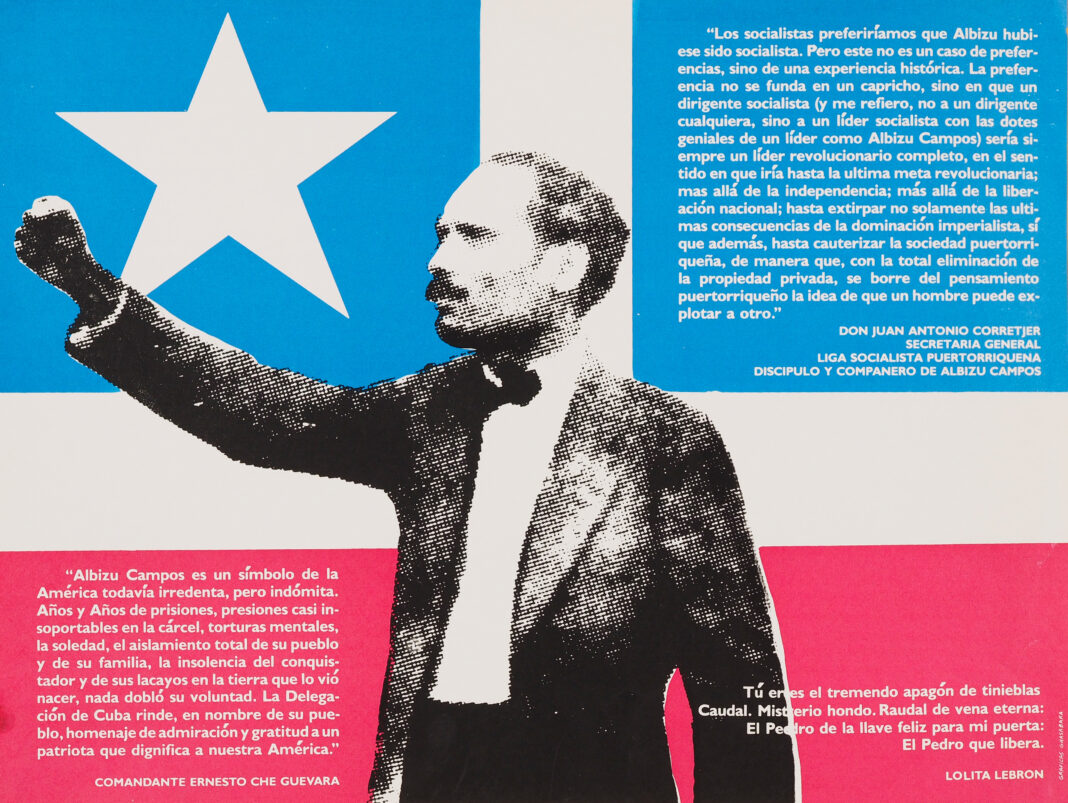
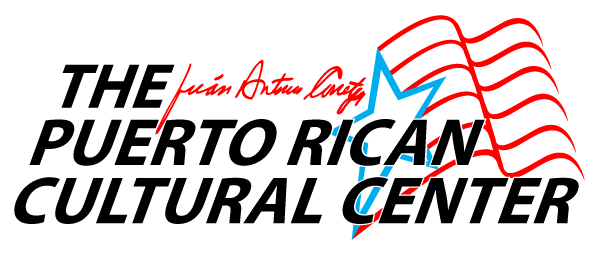

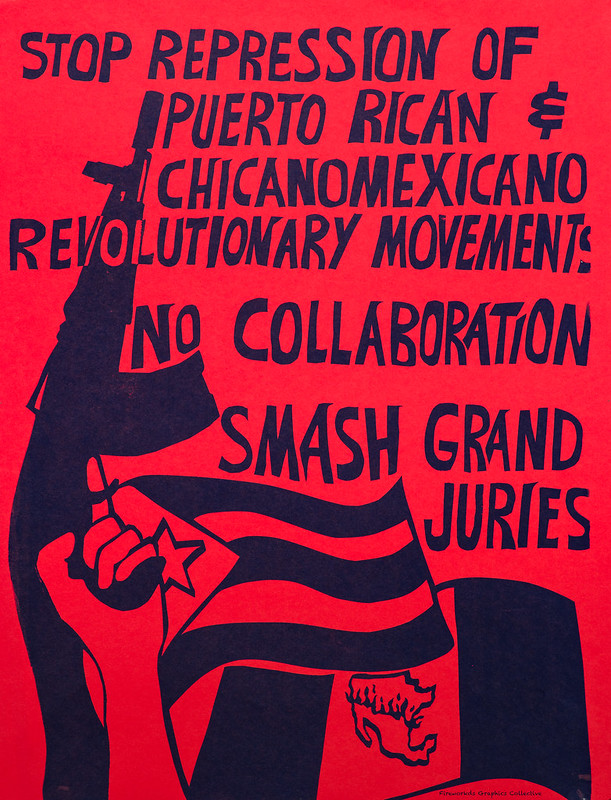
![The conquest and settlement of the northern part of Mexico by the US in the 1840's is a relatively recent event in the history of La Raza on this continent. The US tries to represent the current border between the US and Mexico as fixed and eternal, to hide the historic and continuous relationship between Chicano/ Mejicano struggle within the US and Mejicano struggle in Mexico. This poster, produced in 1981 at the El Paso/Juarez conference (poster 115) shows that the heroes of the chicano and mexicano movements transcend the imperialist borders established by the US. Center: Francisco “Pancho Villa, a leader in the Mexican Revolution. Top left: Ricardo Flores Magon, one of three brothers, was a noted anarchist and revolutionary thinker. Top Center: Genaro Vasquez Rojas, leader of the guerrilla organization, Asociación Nacional Revolucionaria (National Revolutionary Association), developed out of the state of Guerrero. Top right is a pecan sheller from an historic strike in San Antonio in the 1930’s. Center right is Valentina Ramirez Avitia, also known as a soldadera, a woman who fought in the Mexican revolution under the name Juan Ramirez, when women were not allowed to join the army. Bottom left, Ricardo Falcon, a student and a leader of the Chicano movement, was killed in a racist incident in 1972. Center left, Juana Belen Gutierrez de Mendoza, Mexican anarchist, feminist, and journalist, and a Caxcan Indian from the state of Durango.[3]](https://live.staticflickr.com/65535/52631877321_7f588a8355_c.jpg)

